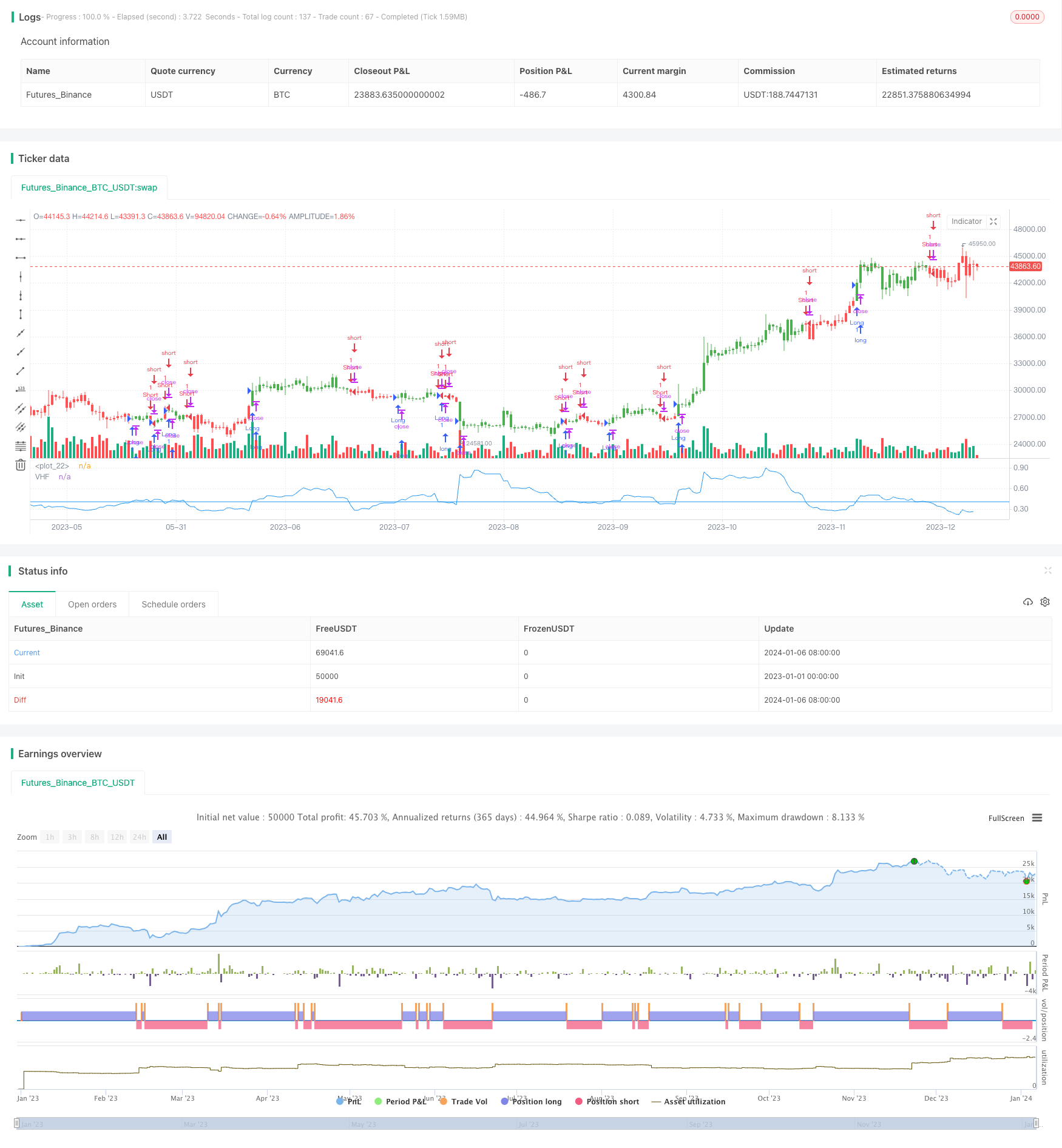Vertical Horizontal Filter Backtest Strategy
Author: ChaoZhang, Date: 2024-01-08 10:20:25Tags:

Overview: This strategy judges whether prices are in a trend state by calculating the ratio between the difference between the highest and lowest prices over a certain period and the amplitude of the closing price, and uses this as a trading signal indicator.
Strategy Principle: The core indicator of this strategy is Vertical Horizontal Filter (VHF). It is calculated by the following formula:
VHF = (Highest(Length) - Lowest(Length)) / SUM(ABS(Close-Close[1]), Length)
Where Highest(Length) and Lowest(Length) are respectively the highest and lowest prices within the Length cycle. The numerator reflects the amplitude range of prices, and the denominator reflects the actual fluctuation of prices. Their ratio can judge the trend of price moves. When VHF is higher than a given signal threshold, it is considered that prices are in a trend state. When lower than the given signal threshold, it is considered that prices are in a shock state. Trading signals are generated accordingly.
This strategy is simple and intuitive. By comparing the price fluctuation range with the actual fluctuation to judge the trend, it avoids the problem of relying solely on SMA, EMA and other indicators while ignoring the characteristics of the price itself. But this strategy is sensitive to parameter optimization, Length and Signal parameters need to be adjusted to adapt to different cycles and market conditions.
Advantage Analysis:
- Intuitive trend judgment indicator, simple and effective.
- Consider the characteristics of the price itself, does not rely on any curve fitting.
- Configurable parameters adjust the sensitivity of judgment.
- Can be easily integrated into various trading strategies.
Risk Analysis:
- Sensitive to parameters, improper settings can cause too many false trades.
- Unable to distinguish pseudo trends when prices are at inflection points.
- Not sensitive to short-term price shocks under large cycle settings.
- Need to use stop loss to control single loss.
Optimization Directions:
- Optimize Length parameter to balance the sensitivity of trend judgment.
- Combine other indicators to filter VHF signals. For example, MACD can determine inflection points.
- Try machine learning methods to fit the VHF curve.
- Set up parallel strategies with different cycle settings to generate multi-level strategy signals.
Summary: This strategy intuitively determines the trend based on the characteristics of the price itself, simple and valid, worth further exploration, optimization and verification. It can become a basic trend judgment tool and widely used in quantitative trading strategies.
/*backtest
start: 2023-01-01 00:00:00
end: 2024-01-07 00:00:00
period: 1d
basePeriod: 1h
exchanges: [{"eid":"Futures_Binance","currency":"BTC_USDT"}]
*/
//@version=2
////////////////////////////////////////////////////////////
// Copyright by HPotter v1.0 27/04/2018
// Vertical Horizontal Filter was initiated by Adam White. It was first published
// in a magazine called “Issues of Futures” in August, 1991. The Vertical Horizontal
// Filter (VHF) is a very common Indicator used by traders to find out the Phase of
// a Price Trend. Normally, a price trend can be in a Trending Phase or a Congestion
// Phase/Choppy Movement Phase. Adam White created this particular Technical Indicator
// to determine whether prices are trending in a particular direction or are they going
// through a transitional period. He used it to measure the range of Futures available
// in the market.
//
// You can change long to short in the Input Settings
// WARNING:
// - For purpose educate only
// - This script to change bars colors.
////////////////////////////////////////////////////////////
strategy(title="Vertical Horizontal Filter Backtest")
Length = input(28, minval=1)
Signal = input(0.4, step=0.01)
reverse = input(false, title="Trade reverse")
hline(Signal, color=blue, linestyle=line)
xHH = highest(high, Length)
xLL = lowest(low, Length)
xNumerator = abs(xHH - xLL)
xDenominator = sum(abs(close - close[1]), Length)
xVHF = xNumerator / xDenominator
pos = iff(xVHF > Signal, 1,
iff(xVHF < Signal, -1, nz(pos[1], 0)))
possig = iff(reverse and pos == 1, -1,
iff(reverse and pos == -1, 1, pos))
if (possig == 1)
strategy.entry("Long", strategy.long)
if (possig == -1)
strategy.entry("Short", strategy.short)
barcolor(possig == -1 ? red: possig == 1 ? green : blue )
plot(xVHF, color=blue, title="VHF")
- Multi-Timeframe Trailing Stop Loss Strategy
- Momentum Dual Moving Window TSI Indicator
- RSI and Bollinger Bands Profitable Strategy
- Buy/Sell on Candle Close Strategy
- Supertrend Take Profit Strategy
- Price Channel Trend Following Strategy
- Dual Moving Average Counter Trend Strategy
- Positive Bars Percentage Breakout Strategy
- RSI Dual-track Breakthrough Strategy
- Crude Oil Moving Average Crossover Strategy
- RSI and Bollinger Bands Quantitative Trading Strategy
- ZigZag Trend Following Strategy
- Supertrend Advance Strategy
- Midnight Candle Color Strategy with Stop Loss and Take Profit
- ATR Trend Following Strategy Based on Standard Deviation Channel
- ATR Based Trend Tracking Strategy
- Quantitative Trading Strategy Combining RSI, MACD and Support/Resistance
- RSI Trend Tracking Long Only Strategy
- Double Channel Breakthrough Turtle Strategy
- Improved RSI MACD Moving Average Strategy